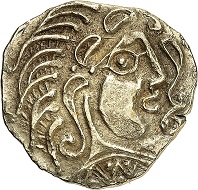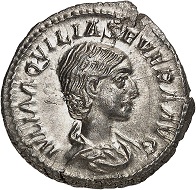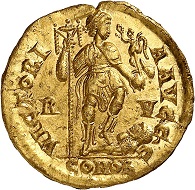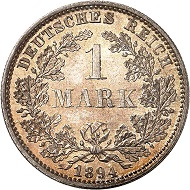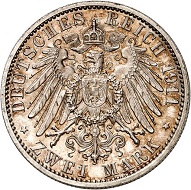14-05-2018 – 15-05-2018
Auction 74
Selected Rarities in outstanding grades at the Heidelberger Münzhandlung
Do you still have an AKS- or a Jaeger-number on your personal checklist? If the answer is yes, you can look forward to the upcoming auction 74 at the Heidelberger Münzhandlung. It offers German rarities en masse: In great collector’s quality but also in perfect grades, because the auction does not only entail the “normal” content but also the Gunter Vohrer collection of German coins since 1800.
In addition, collectors will discover a special collection of Roman coins with women’s portraits as well as a large lot of France and also a small selection of coins from Mainz, German ducats in outstanding condition and numerous rarities from the German States, Europe and world coins.
No. 1. Celts. Parisii. Gold stater. Very rare. Very fine to extremely fine. Estimate: 9,000 euros.
Ancient Coins
The auction starts with three lots from Celtic coins and around 40 lots of Greek coins. Next there will be a series of roughly 90 coins from the Roman Republic before we will come to the first special collection.
No. 167. Aquilia Severa, 2nd wife of Elagabalus. Denarius. Extremely fine. Estimate: 100 euros.
It is dedicated to the women of the Roman Empire. The spectrum ranges from the denarius of Tiberius with a female deity on the reverse who is often identified as Livia, to an aureus of Plotina, denarii for Iulia Paula or Aquilia Severa to a tremissis of Aelia Pulcheria. The estimates are very attractive and all of these coins are worth taking a closer look.
No. 340. Constantinus III, 421. Solidus, Ravenna. Extremely rare. Extremely fine to FDC. Estimate: 20,000 euros.
The same applies to the 150 lots with coins from the Roman imperial period. Every collector will find something here – the ones who have to keep an eye on their budget as well as those who are looking for a great rarity in splendid condition. Coins of Constantinus III are rare as it is. The emperor, who is often referred to as the grandfather of King Arthur by medieval authors, only reigned for a few years after he had been declared emperor by his troops in Britain.
The Heidelberger Münzhandlung is able to offer two of his solidi at once, one from Trier (Estimate: 10,000 euros) and one which was minted in the Italian city Ravenna (Estimate: 20,000 euros).
No. 699. France. 50 Francs 1887, Paris. Very rare date. Extremely fine to FDC. Estimate: 5,000 euros.
Special collection France
More than 350 lots with coins from France are the climax of European coins. The spectrum ranges from Louis VII (1137-1180) until the present. As always, there are specimens of outstanding grades in the auction, and a variety of rare fractions from different mints as well as some patterns. If you are looking for extraordinary numismatic objects, you would be best advised to read this section carefully.
No. 727. France. Dombes. Louis II de Bourbon-Montpensier, 1560-1582. Écu d’or (demi pistole) 1577. Very rare. Very fine to extremely fine. Estimate: 4,000 euros.
The royal France will be complemented by a series of rare Féodal-coins: Let us point out this demi pistole from 1557 of the prince of Dombes, Louis II of Bourbon-Montpensier. But there is also an écu from 1650 by the prince Guillaume IX of Orange, a very fine and attractive coin with a fine patina (Estimate: 4,000 euros), which is worth mentioning.
No. 798. Italy. Vatican. Innocent XI., 1676-1689. Quadrupla n. y., AN II (1677), Rome. Extremely rare. Almost extremely fine. Estimate: 30,000 euros.
Another highlight of European coins will be an extremely rare quadrupla from the second year, 1677, of Pope Innocent XI. It is a coin by the famous papal die cutter Giovanni Hamerani (1649-1705) which unites the saints Augustine, Lawrence, Stephen and Francis of Assisi in adoration of the Mother of God on the throne. This extremely rare coin is estimated at 30,000 euros.
No. 972. China. Fengtien. 1 Dollar, year 33 (= 1907). Extremely fine. Estimate: 5,000 euros.
Let us not forget the small series of 35 lots of Chinese coins and bars. It entails some rare, NGC-certified coins like a dollar of the province Fengtien from the year 24 (=1898) in extremely fine +, NGC AU 58 (Estimate: 5,000 euros) and another dollar from this province from the year 33 (= 1907) in extremely fine, NGC AU 55.
No. 1070. Salzburg. Max Gandolph, 1668-1687. 3 ducats 1682 for the 1100-year-jubilee. Extremely rare. Extremely fine to FDC. Estimate: 6,000 euros.
Holy Roman Empire and Austrian mediatized houses
And with that we arrive at the coins of the Holy Roman Empire and the mediatized houses. One of the most attractive coins is probably the triple ducat of Salzburg from 1682 on occasion of the 1100-year-jubilee of the archbishopric in 1682. It does not only show famous saints like Martin of Tours with his goose, St. Vincent in a deacon’s dress, but it also shows some lesser known Saints like Saint Hermes, Chrysanthus and Daria. Their bones had been taken away because of the reconstruction of the cathedral in 1602. In 1682, after the construction works had been completed, the Salzburg clergy transferred the relics back to the dome in an impressive baroque procession.
No. 1127. Bavaria. Albert V, 1550-1579. Ducat n. y. Extremely rare. Extremely fine to FDC. Estimate: 30,000 euros.
German States
And now let us come to the coins of the German States! As always, the Heidelberger Münzsammlung presents you with a number of rarities in this category. There is an extensive collection of ducats, some of which we will briefly introduce in this preliminary report. Let us begin with Bavaria, where 70 lots are from: This extremely rare and splendid ducat by Albert V, who was a passionate coin collector and laid the foundation of a collection which is still kept at the Munich Residenz. No wonder he also hired a brilliant die cutter for his own portrait.
No. 1151. Bavaria. Charles Theodore, 1777-1799. Danube-gold-ducat 1793. Extremely rare. Extremely rare to FDC. Estimate: 20,000 euros.
This extremely rare Danube-gold-ducat by Charles Theodore from the year 1793 is another example. It does not show the more common signature HS underneath the prince’s portrait but ST.
No. 1352. Löwenstein-Wertheim-Virneburg. Johann Ludwig Vollrath, 1730-1790. Ducat 1769, Wertheim. Extremely rare. Extremely fine. Estimate: 15,000 euros.
The probably rarest ducat of the collection comes from Löwenstein-Wertheim-Virneburg, a small territory without any political significance. Johann Ludwig Vollrath, the count of Löwenstein-Wertheim-Virneburg, minted ducats in 1769 nevertheless. They are extremely rare today. They proudly present his motto SUUM CVIQUE (= to each his own) above the count’s crown.
No. 1356. Mainz. Arnold of Selenhofen, 1153-1160. Bracteat, Erfurt. Extremely rare. Almost extremely fine. Estimate: 3,500 euros.
Special collection Mainz
And with that, we have arrived at our next highlight, a small special collection of coins from Mainz – bracteats of Arnold of Selehofen (1153-1160) to ducats of Emerich Joseph, Freiherr von Breitbach-Bürresheim.
No. 1372. Mainz. Karl Heinrich von Metternich-Winneburg. Sortengulden at 60 kreuzer 1679. Extremely rare. Almost FDC. Estimate: 7,000 euros.
Next to countless gold coins, you will also find two precious portrait coins: An extremely rare taler from 1676 of Damian Hartard von Leyen (Estimate: 6,000 euros) and a gulden at 60 kreuzer from 1679 of Karl Heinrich von Metternich-Winneburg (Estimate: 7,000 euros.)
No. 1669. Württemberg. William I, 1816-1864. Ducat 1818. Very rare. Extremely fine to FDC. Estimate: 8,000 euros.
Let us conclude our report on coins of the German States (and the collection of splendidly preserved ducats) with an example from Württemberg, a very rare ducat from 1818 by king William I in extremely fine to FDC (Estimate: 8,000 euros).
No. 1788. German Empire. 1 mark 1894 G. Rare in this condition! FDC. Estimate: 1,200 euros.
Coins from the German Empire
After an extensive series of medals, we will come to a specialty at the Heidelberger Münzhandlung – coins of the German Empire. Those who collect them know that Herbert Grün does not only sell gorgeous gold and silver coins but that there is also a special focus on rare fractions. And this auction will be no different. Be it a first strike of a 10 pfennig coin from 1894 E (Estimate: 1,000 euros), an FDC 1 mark coin from 1894 G (Estimate: 1,200 euros) or an almost FDC 25 pfennig coin from 1909 J (Estimate: 1,000 euros): There is a lot to choose from.
No. 2156. German Empire. Bavaria. Ludwig III, 1913-1918. 20 mark 1914. Only known specimen in this condition. PCGS PR66 D CAM. Proof. Estimate: 15,000 euros.
You will be surprised just how much choice there actually is when it comes to gold coins from the German Empire. Grade fetishists will find a lot to choose from, for instance the best specimen of a Bavarian 20 mark coin from 1914 (J. 202 / Estimate: 15,000 euros). PCGS graded this piece as PR66 D CAM. A lot of coins offered at the auction are graded by the well-known grading companies PSCG and NGC. Another example would be a specimen of a 10 mark coin by the city of Hamburg from 1873, which was graded PF66 Ultra Cameo by NGC (J. 206 / Estimate: 17,500 euros).
No. 2213. German Empire. Hesse. Ludwig IV, 1877-1892. 20 mark 1892. Proof. Estimate: 10,000 euros.
This ungraded but similarly precious Hessian 20 mark coin from 1892 in proof (J. 221 / Estimate: 10,000 euros) would be another perfect example.
No. 2284. German Empire. Reuss Elder Line. Heinrich XXII, 1859-1902. 20 mark 1875. Showpiece of greatest rarity and finest grade! PCGS MS 66. First strike. FDC. Estimate: 50,000 euros.
And if we come to Mecklenburg or even Reuss, there will be no unfulfilled wishes: Mecklenburg-Schwerin, 10 mark 1872 FDC (Estimate: 20,000 euros), 20 mark 1901 proof (15,000 euros), Mecklenburg-Strelitz, 10 mark 1873 FDC (Estimate: 50,000 euros), 10 mark 1880 FDC (Estimate: 25,000 euros), 20 mark 1874 FDC (Estimate: 30,000 euros), 20 mark 1905 proof (Estimate: 20,000 euros), Reuss, 20 mark 1875 first strike, FDC (Estimate: 50,000 euros) or 10 mark 1882 FDC (Estimate: 30,000 euros). All great rarities are in divine condition!
No. 2306. German Empire. Saxony – Coburg – Gotha. Ernst II., 1844-1893. 20 mark 1872. The rarest gold coin of the German Empire in outstanding grade, the best known specimen to Heidelberger Münzhandlung! First strike. Estimate: 125,000 euros.
Who would believe that we have not even reached the climax? The rarest gold coin of the German Empire, 20 mark 1872 from Saxony – Coburg – Gotha will be offered as a first strike in FDC (Estimate: 125,000 euros)!
And it does not stop there. Another rarity from Sachsen-Meiningen should not go unmentioned either: 20 mark 1872 FDC (Estimate: 35,000 euros), 20 mark 1882 FDC (Estimate: 30,000 euros) and 20 mark 1914 proof (Estimate: 20,000 euros).
Of course, as always, there is also a large selection of coins from after the end of the First World War.
No. 3133. German Empire. Saxony – Altenburg. Charles Edward, 1900-1918. 2 mark 1911. On occasion of the hereditary prince’s baptism. Only 100 specimens minted. With Paproth-expertise. FDC. Estimate: 10,000 euros.
Gunter Vohrer collection
After these extremely rare gold coins – only few of which will be affordable for many people – let us return to a collector’s everyday world. After all, if you have to pass on perfect gold, you will find all the more interesting material in the Gunther Vorher collection of German coins after 1800 with a great variety of large silver coins and fractions especially. You will not find gold here. Instead there are extraordinary coins, some of which in surprisingly high grade.
No. 2950. German Empire. 5 pfennig 1896 G. Only few specimens known! With Paproth-expertise. Almost very fine. Estimate: 3,000 euros.
Just to give you an example how rare some of the catalogued coins are, let us mention the 5 pfennig coin from 1896 with the letter G, only few specimens of which are known. This almost very fine, but really attractive coin will be delivered with a Paproth-Expertise to prove its authenticity.
The catalogue can be bought for a cost price of 12.50 euros at the Heidelberger Münzhandlung Herbert Grün, Gaisbergstr. 40, 69115 Heidelberg; Tel: ++49 / 6221 / 65 2970; Fax: ++49 / 6221 / 65 297-29; via e-mail or on the website.
And you can have a look at the catalogue online at this address, as well as on Sixbid.
And here is auction 74 / part 2 – the Gunter Vohrer collection.



